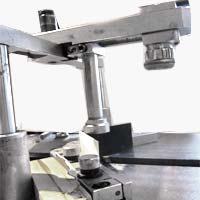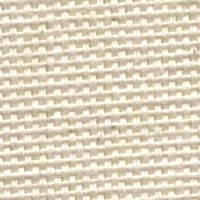| Glossary Of Picture Framing Terms
[7] |
U
Ultraviolet "UV" light has a shorter wavelength than visible light and is found in both natural and artificial light sources. UV light can damage artwork by causing fading, cracked paint and other chemical changes. Conservation-grade framing materials are UV-protected; this includes acrylic and glass covers, mat boards, backing and art paper/canvas. |
Underpinner A machine, generally operated manually with pneumatic assistance, that is used to join picture frame length moulding in the construction of the frame. The mitered corners of two moulding pieces are set together on the machine to create a 90 degree angle. When a lever or button is pressed, a foot is lowered to hold the pieces down, while V-nails or other fasteners are forced into the underside of the wood, holding the corner together.
Order online: Underpinner Wedge Nails |
 |
| Uni-frames A frameless display product that holds the artwork between two panes of glass or acrylic. Small cleats clip the panes together, and are held in place with string or wire threaded through them from the back. The result is a "floating" artwork that still protects the image. |
| United Inch United inches is a term used in the framing industry to describe the size of a print for the purpose of pricing. The number of united inches in any given image is the sum of its length and its width (one side only for each). Thus, in effect, it represents 1/2 the perimeter of the print. For example, an image that is 10 x 20 has 30 united inches, and a 24 x 36 inch print has 60 united inches. |
Unprimed Canvas An artist's canvas that has not been treated with a clear or white primer. As a result, when the paint is applied, it is readily absorbed into the fibers of the canvas, affecting the appearance. Though whether or not to use unprimed canvas is the choice of the artist, in the case of oil painting unprimed canvas can be problematic, since the oil paints will cause the raw canvas to rot. In addition to creating a smoother surface for the paint, primer protects the canvas from the elements.
Order online: Artist Canvas |
 |
| UV Ultraviolet light. UV rays are beyond the visible spectrum of humans. UV radiation comes from a variety of sources, including the sun, lamps, LEDs, lasers, etc. |
UV Non-Glare Protective Plexiglass Acrylic where one or both surfaces have been treated chemically or mechanically to slightly roughen the surface, causing reflected incident light to be dispersed in all directions, minimizing glare. In addition, the glass is treated to repel UV rays, protecting the artwork from fading, yellowing or peeling. UV plexiglass is considered conservation or archival quality.
Because the glass surface is not smooth, art images behind the glass tend to be softened. The softness depends on how far the art is from the glass. No more than two or three mats are recommended to be used with non-glare glass. If clarity is desired, objects in deep frames (shadow boxes) should not be displayed with non-glare glass.
When you order your framed print, you can choose the best plexiglass for the display.
Or order Plexiglass Mounting Boards |
|
© 2002-2025 - KeenART Media Ltd.
|
|
| |
|
